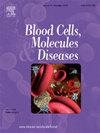Anti-sickling efficacy and safety of Sailin-HbS, an indigenous Ayurvedic formulation
IF 1.7
4区 医学
Q3 HEMATOLOGY
引用次数: 0
Abstract
Sickle Cell Disease (SCD) is a hereditary condition characterized by a mutation in globin chains of hemoglobin. Polymerization of deoxygenated sickle hemoglobin (HbS) leads to rigid sickle shaped red blood cells (RBC), the primary cause of SCD pathobiology and multiple comorbidities including organ damage and pain. Gene therapy is the only treatment to reduce sickling, but its limitations including high cost, advanced technical resources and age limit pose a major challenge in its application. We examined the potential of a nutraceutical Sailin-HbS, formulated from the extract of 5 different plant sources with anti-oxidant and anti-inflammatory property, to ameliorate RBC sickling. Using sickle RBCs from individuals with SCD (SS-RBCs), Sailin-HbS demonstrated ∼74 % inhibition of sickling under low oxygen conditions; and significantly inhibited hypoxia-induced HbS polymerization by reducing polymerization kinetics at 700 nm. Osmotic fragility tests demonstrated enhanced resistance of SS-RBCs to osmotic stress in the presence of Sailin-HbS. We compared the anti-sickling effect of Sailin-HbS with known anti-sickling agents, Niprisan, SCD 101, AES-103/5-HMF and GBT440/Voxelotor, and found it to be equally and/or more effective. We tested the safety/toxicity of Sailin-HbS in 2 rodent models which showed a high safety threshold, with an oral LD50 exceeding 2000 mg/kg, placing it within the OECD-GHS category class 5. Sub-acute and chronic toxicity assessments in rats reveal no adverse effects on organ function or body weight, biochemical parameters, or complete blood counts, demonstrating its safety profile with established threshold levels. Thus, Sailin-HbS exhibits considerable anti-sickling efficacy without inducing toxicity, suggesting its translational potential in SCD.

本土阿育吠陀配方Sailin-HbS的抗镰状病功效和安全性
镰状细胞病(SCD)是一种以血红蛋白珠蛋白链突变为特征的遗传性疾病。脱氧镰状血红蛋白(HbS)聚合导致坚硬的镰状红细胞(RBC),这是SCD病理生物学和包括器官损伤和疼痛在内的多种合并症的主要原因。基因治疗是减少镰状病的唯一治疗方法,但其成本高、技术资源落后、年龄限制等局限性给其应用带来了重大挑战。我们研究了一种营养保健品Sailin-HbS的潜力,该营养品由5种不同植物来源的提取物配制而成,具有抗氧化和抗炎特性,可以改善红细胞镰状细胞。使用来自SCD患者的镰状红细胞(ss - rbc), Sailin-HbS在低氧条件下显示出~ 74%的镰状红细胞抑制作用;并通过降低700 nm聚合动力学显著抑制缺氧诱导的HbS聚合。渗透脆弱性测试表明,在Sailin-HbS的存在下,ss -红细胞对渗透胁迫的抵抗力增强。我们将Sailin-HbS的抗镰状细胞效应与已知的抗镰状细胞效应药物Niprisan、SCD 101、es -103/5- hmf和GBT440/Voxelotor进行了比较,发现它们的抗镰状细胞效应相同,甚至更有效。我们在2种啮齿动物模型中测试了Sailin-HbS的安全性/毒性,结果显示出较高的安全阈值,口服LD50超过2000 mg/kg,将其列入OECD-GHS类别5类。大鼠的亚急性和慢性毒性评估显示,对器官功能或体重、生化参数或全血细胞计数没有不良影响,表明其在既定阈值水平下的安全性。因此,Sailin-HbS在不诱导毒性的情况下表现出相当大的抗镰状细胞损伤作用,提示其在SCD中的翻译潜力。
本文章由计算机程序翻译,如有差异,请以英文原文为准。
求助全文
约1分钟内获得全文
求助全文
来源期刊
CiteScore
4.90
自引率
0.00%
发文量
42
审稿时长
14 days
期刊介绍:
Blood Cells, Molecules & Diseases emphasizes not only blood cells, but also covers the molecular basis of hematologic disease and studies of the diseases themselves. This is an invaluable resource to all those interested in the study of hematology, cell biology, immunology, and human genetics.

 求助内容:
求助内容: 应助结果提醒方式:
应助结果提醒方式:


